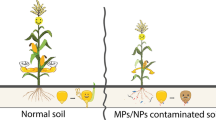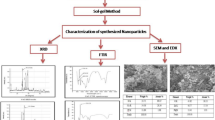Abstract
A reasonable understanding of the impact and health risk of the metal oxide nanoparticles treated on edible plants is necessary in order to use nanomaterials in food and medicine. In this study, we investigate the uptake and toxic response of transition metal oxides, namely Fe2O3, CuO and ZnO nanoparticles synthesised by co-precipitation method using nitrate salts of the respective metals as precursors. The characterisation of all the prepared nanoparticles shows the purity above 97% with rod-like morphology. Cowpea (Vigna unguiculata) seeds are soaked in a monodispersed solution of nanoparticles and kept for seed germination and plant growth. Transport and accumulation of the nanoparticles treated in the seeds are assessed through X-ray fluorescence spectroscopy which confirms the uptake of the nanoparticles with respect to the treatment regime. The seeds soaked in CuO nanoparticles reveal better seed germination percentage, an increased coleoptile length and a plant height at 100 ppm concentration than other nanoparticles. This study proves the limitation of CuO nanoparticle application for better growth of cowpea plants whereas iron and zinc oxide nanoparticles show promising response in plant growth, uptake and bioavailability in seeds even at higher treatments.

Graphical Abstract






Similar content being viewed by others
References
Jiang, J., Oberdorster, G., & Biswas, P. (2009). Characterization of size, surface charge, and agglomeration state of nanoparticle dispersions for toxicological studies. Journal of Nanoparticle Research, 11, 77–89.
Ma, X., Geiser-Lee, J., Deng, Y., & Kolmakov, A. (2010a). Interactions between engineered nanoparticles (ENPs) and plants: phytotoxicity, uptake and accumulation. Science of the Total Environment, 408, 3053–3061.
Asli, S., & Neumann, P. M. (2009). Colloidal suspensions of clay or titanium dioxide nanoparticles can inhibit leaf growth and transpiration via physical effects on root water transport. Plant, Cell & Environment, 32, 577–584.
Huang, Z., Zheng, X., Yan, D., Yin, G., Liao, X., Kang, Y., Yao, Y., Huang, D., & Hao, B. (2008). Toxicological effect of ZnO nanoparticles based on bacteria. Langmuir, 24, 4140–4144.
Bombin, S., LeFebvre, M., Sherwood, J., Xu, Y., Bao, Y., & Ramonell, K. M. (2015). Developmental and reproductive effects of iron oxide nanoparticles in Arabidopsis thaliana. International Journal of Molecular Sciences, 16(10), 24174–24193.
Kahru, A., & Dubourguier, H. C. (2010). From ecotoxicology to nanoecotoxicology. Toxicology, 269, 105–119.
Karunakaran, G., Suriyaprabha, R., Manivasakan, P., Yuvakkumar, R., Rajendran, V., & Kannan, N. (2013). Effect of nanosilica and silicon sources on plant growth promoting rhizobacteria, soil nutrients and maize seed germination. IET Nanobiotechnology, 7(3), 70–77.
Suriyaprabha, R., Karunakaran, G., Yuvakkumar, R., Rajendran, V., Prabu, P., & Kannan, N. (2012). Growth and physiological responses of maize (Zea mays L.) to porous silica nanoparticles in soil. Journal of Nanoparticle Research, 14, 1–14.
Suriyaprabha, R., Karunakaran, G., Yuvakkumar, R., Rajendran, V., & Kannan, N. (2014). Augmented biocontrol action of silica nanoparticles and Pseudomonas fluorescens bioformulant in maize (Zea mays L.). RSC Advances, 4, 8461–8465.
Krishnaraj, C., Jagan, E. G., Ramachandran, R., Abirami, S. M., Mohan, N., & Kalaichelvan, P. T. (2012). Effect of biologically synthesized silver nanoparticles on Bacopa monnieri (Linn.) Wettst. Plant growth metabolism. Process Biochemistry, 47, 651–658.
Ma, Y., Kuang, L., He, X., Bai, W., Ding, Y., Zhang, Z., Zhao, Y., & Chai, Z. (2010b). Effects of rare earth oxide nanoparticles on root elongation of plants. Chemosphere, 78, 273–279.
Khodakovskaya, M., Dervishi, E., Mahmood, M., Xu, Y., Li, Z., Watanabe, F., & Alexandru, S. B. (2009). Carbon nanotubes are able to penetrate plant seed coat and dramatically affect seed germination and plant growth. ACS Nano, 3(10), 3221–3227.
Dimkpa, C. O., McLean, J. E., Latta, D. E., Manango, E., Britt, D. W., Johnson, W. P., Boyanov, M. I., & Anderson, A. J. J. (2012). CuO and ZnO nanoparticles: phytotoxicity, metal speciation, and induction of oxidative stress in sand-grown wheat. Journal of Nanoparticle Research, 14, 1125.
Atha, D. H., Wang, H., Petersen, E. J., Cleveland, D., Holbrook, R. D., Jaruga, P., Dizdaroglu, M., Xing, B., & Nelson, B. C. (2012). Copper oxide nanoparticle mediated DNA damage in terrestrial plant models. Environmental Science & Technology, 46, 1819–1827.
Barrena, R., Casals, E., Colon, J., Font, X., Sanchez, A., & Puntes, V. (2009). Evaluation of the ecotoxicity of model nanoparticles. Chemosphere, 75, 850–857.
Du, W., Sun, Y., Ji, R., Zhu, J., Wu, J., & Guo, H. (2011). TiO2 and ZnO nanoparticles negatively affect wheat growth and soil enzyme activities in agricultural soil. Journal of Environmental Monitoring, 13, 822–828.
Lin, D. H., & Xing, B. S. (2008). Root uptake and phytotoxicity of ZnO nanoparticles. Environmental Science & Technology, 42, 5580–5585.
Stampoulis, D., Sinha, S. K., & White, J. C. (2009). Assay-dependent phytotoxicity of nanoparticles to plants. Environmental Science & Technology, 43, 9473–9479.
Prasad, T. N. V. K. V., Sudhakar, P., Sreenivasulu, Y., Latha, P., Munaswamy, V., Raja Reddy, K., Sreeprasad, T. S., Sajanlal, P. R., & Pradeep, T. (2012). Effect of nanoscale zinc oxide particles on the germination, growth and yield of peanut. Journal of Plant Nutrition, 35, 905–927.
Yang, J., Cao, W., & Rui, Y. (2017). Interactions between nanoparticles and plants: phytotoxicity and defense mechanisms. Journal of Plant Interactions, 12(1), 158–169.
Boonyanitipong, P., Kumar, P., Kositsup, B., Baruah, S., & Dutta, J. (2011). Effects of zinc oxide nanoparticles on roots of rice Oryza sativa L. International Journal of Bioscience, Biochemistry and Bioinformatics, 4, 283–285.
Lin, D., & Xing, B. (2007). Phytotoxicity of nanoparticles: inhibition of seed germination and root growth. Environmental Pollution, 150(2), 243–250.
Rico, C. M., Majumdar, S., Duarte-Gardea, M., Peralta-Videa, J. R., & Gardea-Torresdey, J. L. (2011). Interaction of nanoparticles with edible plants and their possible implications in the food chain. Journal of Agricultural and Food Chemistry, 59(8), 3485–3498.
Shi, J., Abid, A. D., Kennedy, I. M., Hristova, K. R., & Silk, W. K. (2011). To duckweeds (Landoltia punctata), nanoparticulate copper oxide is more inhibitory than the soluble copper in the bulk solution. Environmental Pollution, 159, 1277–1282.
Yuan, J., He, A., Huang, S., Hua, J., & Sheng, G. D. (2016). Internalization and phytotoxic effects of CuO nanoparticles in Arabidopsis thaliana as revealed by fatty acid profiles. Environmental Science & Technology, 250(19), 10437–11044.
Siddiqi, K. S., & Husen, A. (2016). Engineered gold nanoparticles and plant adaptation potential. Nanoscale Research Letters, 11, 400.
Wang, P., Menzies, N. W., Lombi, E., McKenna, B. A., Johannessen, B., Glover, C. J., Kappen, P., & Kopittke, P. M. (2013). Fate of ZnO nanoparticles in soils and cowpea (Vigna unguiculata). Environmental Science & Technology, 47(23), 13822–13830.
Acknowledgements
One of the authors (R.S) is thankful to the University Grants Commission (UGC), New Delhi, for the award of Post-Doctoral Fellowship for Women (F.15-1/2015-17/PDFWM-2015-17-TAM-36274 dt.12/10/2015) to carry out this research work.
Author information
Authors and Affiliations
Corresponding author
Rights and permissions
About this article
Cite this article
Suriyaprabha, R., Sreeja, K.A., Prabu, M. et al. Bioaccumulation of Transition Metal Oxide Nanoparticles and Their Influence on Early Growth Stages of Vigna unguiculata Seeds. BioNanoSci. 8, 752–760 (2018). https://doi.org/10.1007/s12668-018-0535-2
Published:
Issue Date:
DOI: https://doi.org/10.1007/s12668-018-0535-2




